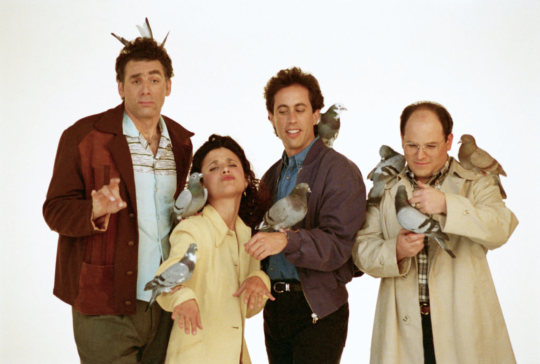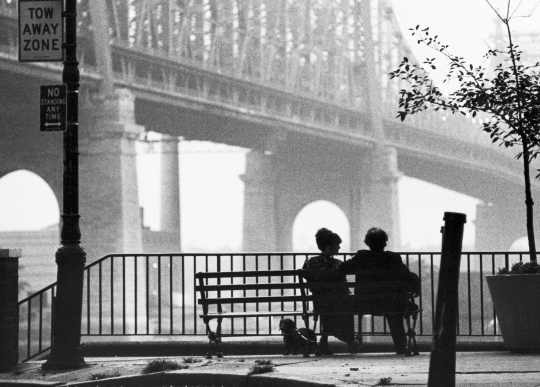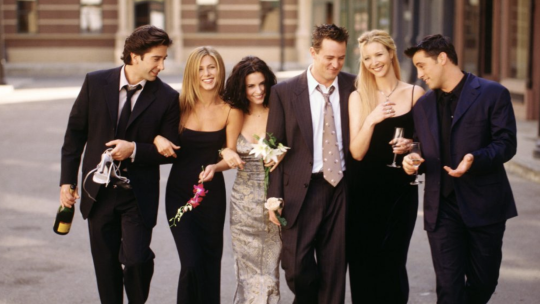Unbroken Windows: How New York Gentrified Itself On Screen by Jason Bailey
By Yasmina Tawil

It was 1972, and Lewis Rudin had a problem—specifically, a Johnny Carson problem. Rudin, a real estate developer and committed New Yorker, had founded the Association for a Better New York (ABNY), an organization dedicated to cleaning up the city’s image (and thus, its attractiveness to corporate clients) via aggressive campaigning and spit-shine marketing; the organization was, for example, instrumental in the development of the iconic I NY campaign.
But all the good work ABNY was doing, Rudin fumed to the organization’s executive director Mary Holloway, felt like pushing Sisyphus’ boulder when he switched on NBC late at night: “How can we change the image of New York when Johnny Carson’s opening monologue every night is about people getting mugged in Central Park?”
As reported by Miriam Greenberg in her book Branding New York: How a City in Crisis Was Sold to the World, Rudin went to the trouble of meeting with network heads, imploring them to pressure personalities like Carson to lighten up on the “New York City is a crime-ridden cesspool” jokes. In 1973, Mayor John Lindsay himself called network executives and even some comedians to a City Hall meeting where he made a similar plea. This was in stark contrast to the usual modus operandi of the Mayor’s Office of Film, Theatre, and Broadcasting, which prided itself on avoiding censorship or editorial interference in the making of motion pictures in the city—indeed, several of the grimmest, grimiest portraits of life in New York (Death Wish, Panic in Needle Park, Little Murders, The French Connection) were borne of this period. But people had to go out to see those. Johnny Carson came into their living room every night to tell them what a shithole New York was.

Rudin and Lindsay’s efforts were ultimately unsuccessful. Johnny Carson continued to roast the city—especially after escaping it when The Tonight Show relocated to Burbank, California in 1972—and prime-time comedies like All in the Family, Taxi, and Welcome Back, Kotter mined similar veins of urban unrest. Meanwhile, gritty crime series from Kojak to Cagney & Lacey to The Equalizer presented a similar picture of the city—dirty, grimy, and dangerous—to that of films like Taxi Driver, The Taking of Pelham One Two Three, The Warriors, and Fort Apache, The Bronx.
But in the 1990s, that all changed. And there’s a compelling case to be made that the change began with Jerry Seinfeld.
*

If we talk about Jerry Seinfeld, of course, we have to talk about Woody Allen, and not just their obvious similarities (roots in stand-up comedy, neurotic Jewish New Yorker persona, tabloid mainstay). In the 1970s and 1980s, while most New York movies were dwelling in the horrors and shortcomings of the city, Allen insulated himself in his upper-class Upper East Side neighborhood and made movies about people who were mostly untouched by crime, homelessness, and graffiti. In films like Annie Hall, Manhattan, Hannah and Her Sisters, and Crimes and Misdemeanors, Allen’s characters sip wine and trade hard truths and pointed witticisms at the city’s finest restaurants, parties, and apartments as the city burns around them; in Manhattan (which, by its own opening monologue admission, romances the city “all out of proportion”) he even edited out a joke about muggings from a Central Park carriage ride sequence, so as not to spoil the delicate mood. Allen’s New York was “not another world,” Martin Scorsese once said. “It’s another planet.”
That vision of New York—upper-crust, erudite, sophisticated—wasn’t entirely absent from the big and small screen in the ‘70s and ‘80s, thanks to films like An Unmarried Woman and Kramer Vs. Kramer, and such TV shows as Diff’rent Strokes and The Cosby Show. But Allen’s films, and even more so Rob Reiner and Nora Ephron’s Allen-esque When Harry Met Sally (a far bigger commercial success than any of Woody’s work), created a vision of comfortable, upscale, wise-cracking New York living that would reach a mass audience via Seinfeld, which debuted in 1989.

The first two brief seasons of Seinfeld (or, as it was originally titled, The Seinfeld Chronicles) struggled in the ratings, but it slowly built an audience and climbed in the Nielsens, and by season five (1993-1994) it was one of the top five shows on the air, anchoring NBC’s “Must See TV” line-up of Thursday night sitcoms. In September 1994, it was joined on Thursdays by another comedy, in which urbane New York pals joked, dated, and shared the horrors of city living. Friends, however, was a rating smash right away, and not only because of its killer schedule placement. It sanded away the rougher edges of Seinfeld; its characters were more likable (or, at least, intended to be), and its humor was less spiky. It ran even longer than Seinfeld, ten seasons, every one of them in the top ten, all but one in the top five.
*
Even as these New York comedies—and others that followed, like Mad About You, Caroline in the City, and The Single Guy—were topping the ratings, the face of the city was changing. “Don’t forget to in the late ’80s, you came off of a couple of financial crises, some bad times,” explains agent Chris Fry, of Elegran Real Estate. ”It was a little bit more affordable, things were dropping. And I think the shows that you’re talking about definitely had a positive effect on what people perceived New York City to be.”
Crime was on the decline across the country, but especially in New York City, a drop that began under Mayor David Dinkins and continued under Rudy Giuliani. The latter, in coordination with NYPD commissioner William Bratton, instituted an aggressive policy of enforcing so-called “quality of life” crimes like graffiti, turnstile-jumping, and panhandling; this philosophy, modeled on James Q. Wilson and George L. Kelling’s controversial “broken windows” theory, held that if these comparatively minor yet highly visible crimes were eradicated, the city would look clean and controlled, and thus psychologically discourage a lawlessness that would result in fewer serious offenses like murder, rape, and theft.

This vision of the city was certainly reflected in NBC’s Thursday night lineup. The early ‘90s comedies found fodder in the minor inconveniences of city life, but rarely trod into the seediness and crime that defined such earlier sitcoms as Night Court and Barney Miller. Paul and Jamie Buchman’s apartment wasn’t burglarized; none of the Friends were mugged in Central Park. When a blackout hit New York City in the summer of 1977, there were over one thousand fires, over 1500 damaged and/or looted stores, and nearly four thousand arrests. When a blackout hit NBC’s Thursday night New York City in the fall of 1994, Chandler Bing got trapped in an ATM vestibule with a supermodel.
If these sitcoms were the television reflection of the “broken windows” theory, their creators had a much easier time cleaning up New York City—in part because they weren’t shooting in it. Much like the films set in New York City before Mayor Lindsay established the Mayor’s Office of Film, Theatre, and Broadcasting, all of these series were shot on soundstages and backlots in California, with the exception of the occasional second-unit exterior establishing shot. So they took place in New York City, but the version of New York City they presented was highly fictionalized. Just as Paul and Jamie, Jerry and the gang, and the Central Perk crew were funnier and sharper than real New Yorkers (and lived in apartments far beyond their means), the New York they lived in was squeakier and clearer.

“I love Friends,” says Sire Leo Lamar-Becker, who was inspired by the shows of the ‘90s to leave California and move to New York, where he currently works in the fashion industry. “But Friends was so sterile. It didn’t feel real. And what Sex and the City offered was, I felt, a more nuanced portrayal of the city.”
Like the New York movies from the late 1960s onward, Sex and the City had the advantage of authenticity: It was shot entirely in New York, the exteriors and the sets (constructed and filmed at Silvercup Studios) and everything in between. “If you’re familiar with this series, and the movies, the city is integral to it,” explains tour guide Lou Matthews. “They’ve called it, like the fifth girl is the city. It’s really crucial.” As a guide for the “Sex and the City Hotspots Tour,” which On Location Tours has conducted since 2001, Matthews has seen, firsthand, the psychological effect of that particular show.
“I’ve definitely met girls in their twenties, or maybe they’re still in college, on the tour who are saying, ‘Yeah, I fell in love with Sex in the City and New York City because of Sex in the City. And like, I’m already trying to figure out how I can get a job here.’ And then I’ve definitely met a few where the reason they moved here was because of Sex in the City, like they wanted the life that Carrie has. And here they are.”
The life they found was, in most cases, not exactly what these shows promised. “As someone who has lived here for 10 years,” laughs Lamar-Becker, “sure, there are some things that are unrealistic—like, Carrie being able to afford all her shoes. That’s unrealistic. But the feeling of the city is always captured well.”
And that indefinable but unmistakable quality, that feeling of the city, is what’s shifted most over the past quarter-century or so – through Seinfeld and Friends and Sex and the City into 30 Rock and Gossip Girl and Girls, through When Harry Met Sally and You’ve Got Mail to The Devil Wears Prada, Trainwreck, and even The Avengers. Some of that shift in public perception is merely a reflection of reality, of filmmakers and show-runners pointing their cameras at the city and capturing the gentrified, yuppified, Disney-fied mutation it’s become.

But some of that is also life imitating art. Every day, Lou Matthews’s tour bus is filled with people like Sire Leo Lamar-Becker, members of a generation of viewers whose impressions of New York were formed not by Taxi Driver and Kojak, but by the Sex and the City films and Netflix binges of Friends. They watched those shows and memorized those movies, and then migrated to New York City like so many immigrants before them. Their predecessors flocked to Ellis Island, lured by promises of a new world. These settlers came to the Magnolia Bakery, seeking not so much a new world as a better one, full of enviable careers, witty friends, and all the cosmos they could drink.
Lewis Rudin would have been proud.

